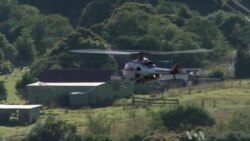Commercial drones, unmanned planes doing regular tasks, are being used more and more around the world. Some assignments for these unmanned aircraft might surprise you, others will amaze you. Think of a drone as a flying camera, capturing pictures impossible for human pilots in large aircraft. But they do more than just take pretty pictures, and are cruising the skies in many countries with few restrictions.
In England, a drone delivers sushi to restaurant tables. It is, in effect, a flying waiter.
In South Africa, drones are conducting wildlife research on elephants, impalas, giraffes and other wild animals.
Over the Pacific Ocean, drones take graceful video of whales at play.
In Indonesia and China, drones will soon transport gold from mines.
Producer Chris Kippenberger, who creates TV commercials in Germany for high-end cars, says drones open up all kinds of possibilities. "You can now keep the principal, keep the natural action that they are doing and start the shot from the top of a building and have the drone fly down to the person."
Pittfalls
Drones have also attracted unwanted attention. Two Canadians were jailed for more than two months in Egypt for filming with a drone. And Turkish police shot down a drone taking pictures of anti-government protesters last year.
The use of drones has raised privacy issues. At a recent U.S. Senate hearing about regulating commercial or private drone use, Henio Arcangeli of Yamaha USA testified about his company's experience with a drone model called the RMax. "During its more than two decades of flight, the RMax logged 1.8 million hours of flight, and to our knowledge had not a single complaint of [invading] privacy."
Mary Cummings, who heads the human and autonomy lab at Duke University, told the Senate Committee on Commerce, Science and Transportation that the United States is not "leading the drone industry - it is lagging."
US Drone Use Lags
Currently, drones can only fly in the U.S. on a limited basis, and typically for research.
David Kirstein, who works on airline regulatory law, says there are good reasons for these limitations. "These technologies are new. They are not proven. Particularly, there are lots of issues [about] mixing them in with other air traffic.”
Privacy advocates such as Leslie Harris, former head of the Center for Democracy & Technology, say laws are needed to protect civil liberties in the face of technological advances. “Technology outstrips law over and over again and it takes years to catch up," Harris said. "We are expanding it off the Internet to devices, to drones, to cars, to refrigerators, and we are going to have to finally make a decision as a country whether we value privacy or not, and if we do, then we have to get some basic laws in place."
The Federal Aviation Administration estimates 7,500 drones will fill American skies within five years, but only after it publishes regulations about their use. Those rules are due next year, but experts doubt the deadline will be met.
In England, a drone delivers sushi to restaurant tables. It is, in effect, a flying waiter.
In South Africa, drones are conducting wildlife research on elephants, impalas, giraffes and other wild animals.
Over the Pacific Ocean, drones take graceful video of whales at play.
In Indonesia and China, drones will soon transport gold from mines.
Producer Chris Kippenberger, who creates TV commercials in Germany for high-end cars, says drones open up all kinds of possibilities. "You can now keep the principal, keep the natural action that they are doing and start the shot from the top of a building and have the drone fly down to the person."
Pittfalls
Drones have also attracted unwanted attention. Two Canadians were jailed for more than two months in Egypt for filming with a drone. And Turkish police shot down a drone taking pictures of anti-government protesters last year.
The use of drones has raised privacy issues. At a recent U.S. Senate hearing about regulating commercial or private drone use, Henio Arcangeli of Yamaha USA testified about his company's experience with a drone model called the RMax. "During its more than two decades of flight, the RMax logged 1.8 million hours of flight, and to our knowledge had not a single complaint of [invading] privacy."
Mary Cummings, who heads the human and autonomy lab at Duke University, told the Senate Committee on Commerce, Science and Transportation that the United States is not "leading the drone industry - it is lagging."
US Drone Use Lags
Currently, drones can only fly in the U.S. on a limited basis, and typically for research.
David Kirstein, who works on airline regulatory law, says there are good reasons for these limitations. "These technologies are new. They are not proven. Particularly, there are lots of issues [about] mixing them in with other air traffic.”
Privacy advocates such as Leslie Harris, former head of the Center for Democracy & Technology, say laws are needed to protect civil liberties in the face of technological advances. “Technology outstrips law over and over again and it takes years to catch up," Harris said. "We are expanding it off the Internet to devices, to drones, to cars, to refrigerators, and we are going to have to finally make a decision as a country whether we value privacy or not, and if we do, then we have to get some basic laws in place."
The Federal Aviation Administration estimates 7,500 drones will fill American skies within five years, but only after it publishes regulations about their use. Those rules are due next year, but experts doubt the deadline will be met.










